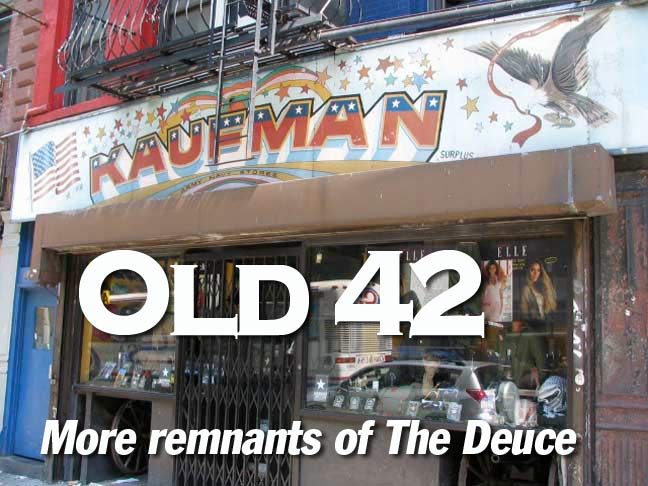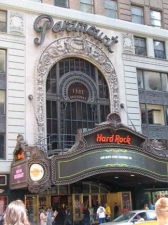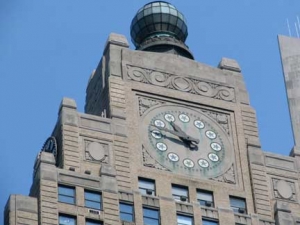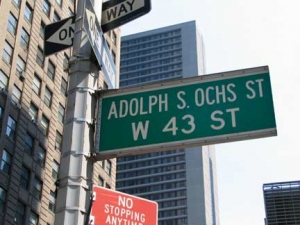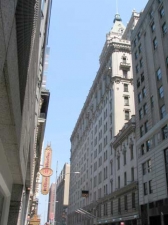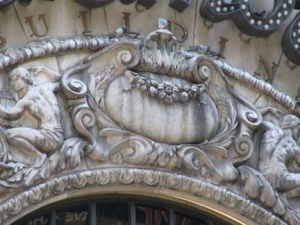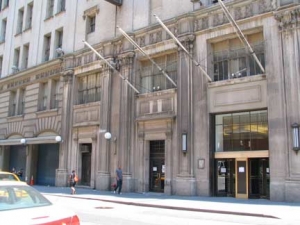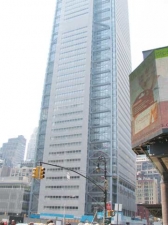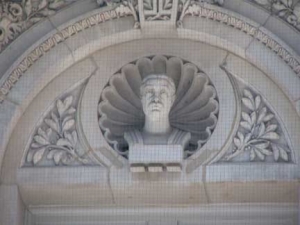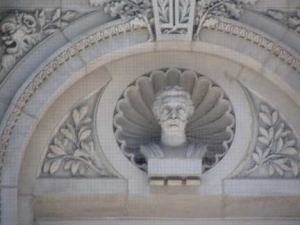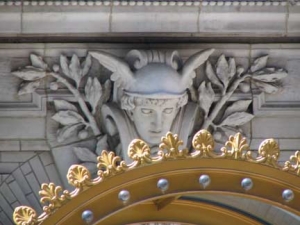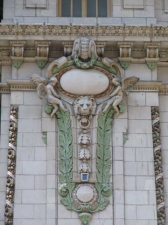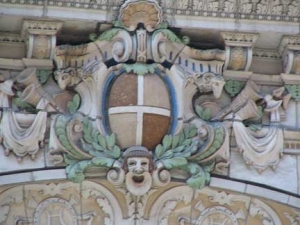Well, hello, yourself. I’ll get it out of the way right here: your webmaster is, of course, the world’s oldest Boy Scout (I performed not one but two good deeds while in San Francisco in August 2008: tracked down the owner of a found cell phone, and returned a comb that fell from a woman’s grip as she ran for a bus) but you’ll be surprised to learn that I regret the loss of sleeze around town.
I do not mourn the loss of the drug-drenched, crime and filth-infested Times Square of old, and by “old” we can now say the period I recall between about 1970 and 1990, when the Crossroads of the World was filthier than the Gowanus Canal and Coney Island Creek put together, and likely had more floating used condoms than either. My own 42nd Street history recollections are sketchy, but in his book The Psychotronic Encyclopedia of Film historian Michael Weldon, for whom I worked briefly, recalls a period in the Swingin’ Sixties when the Deuce had attained a balance of mostly ‘grindhouse’ theatres lined up along 42nd that showed “B’ and “C” movies like Hot Rods to Hell and The Green Slime with a few hardcore XXX houses and “live nude girls” showcases scattered around. Abetted by the mob, porn gradually took over and forced out whatever ‘legit’ stuff was left.
Anyway, you know what happened when Rudolph Giuliani was elected; the city had been trying to evict the pornmeisters since the Age of Koch, but the smutters were seemingly invulnerable to every attempt, as every plan to remake Times Square dissolved in red tape or court cases. I’m not quite sure how Rudy did it — the details are likely enumerated in one of the many books about Times Square history that have been published of late — but Giuliani’s election seemed to galvanize the movement and, by the time I began to set foot in Times Square again in the late 1990s — I was too disgusted to do so in the 1980s, missing out on the chance to capture it at its worst for Forgotten posterity — the old place was mostly shuttered. In its stead roared up the tourist-friendly, G-rated Deuce we see today.
While pure porn has its ideal place on video and the web, where its tendrils cannot encroach upon tenderer sensibilities in public, sexuality will out; nature, or the Almighty, made it pleasurable or the species would not continue. There’s still plenty of softcore around. In the wake of the Times Square cleanup, burlesque has made a comeback and advertising has become ever edgier; Abercrombie & Fitch as well as American Apparel sell clothing by presenting mostly unclad people in their ads. As we’ll touch on here, on this page featuring some buildings and signage dating back to the Deuce and previous, Times Square ads can now be, if not risqué, then rather frank — the 30-ft. tall bikini girl shown above is a Target ad. I’m saying it’s not a bad thing.
I believe it’s a cruder age, which I regret. I don’t know why everyone under about age 30 has to use the word “fuckin'” between every other word. But I also do not know why the sensibilities of children have driven the remake of the “crossroads of the world.” I wish we had grindhouses again, I wish the Playboy Club was back, I’d like something edgier, and I don’t mean Hooters. I don’t know if I’d even patronize these places, but I feel NYC would be ideal with more of ’em.
Matt Weber, who’s been around since the Super 70s, has some terrific (or horrific, if you prefer) pictures of the Deuce in its dubious glory on urbanphotos.
The Paramount Theatre and its skyscraper, at Times Square and West 43rd, was constructed in 1926, C.L and G. W. Rapp, architects, as the flagship NYC thetare for Paramount Pictures. The last movie shown there was the 1965 Bond vehicle Thunderball. It was a premier concert venue during the big bands era of the 1930s and 1940s, and on into the rock era of the 1950s. After the movie theatre was gutted the ground floor was remade as a restaurant and has been home to World Wrestling Entertainment and the current tenant, the Hard Rock Café.
That’s Why It’s Times Square
The New York Times has operated out of two famed towers: One Times Square, in the triangle formed by West 42nd, 7th Avenue and Broadway, with the news “zipper” and multiple claddings over the years, and architect Renzo Piano’s New York Times Building (lower left) at 8th Avenue and West 41st — “Rienzo’s Rods,” which formerly lined the exterior, made it relatively easy for daredevils to get a foothold until they were removed in late 2008.
The building that housed the Times for most of its history, though, at 229 West 43rd Street has gotten relatively little, ah, press. The Times was only in One Times Square from 1905-1913, when it outgrew the relatively thin tower and commissioned a new HQ on West 43rd Street in 1913 by architects Buchman & Fox to house the newsrooms and massive presses. After the Times moved out in 2007, it sold the 43rd Street building to an Israeli investment holding company for over $500 million. It is a designated NYC landmark.
Though the Times no longer operates on West 43rd, the street sign honoring longtime owner, Ohioan Adolph Simon Ochs (1858-1935) remains in place.
Across from the old Times HQ, we see the back end of the Lyric Thatre, which fronts on West 42nd. The Hilton was constructed between 1996 and 1998 from the remnants of the Apollo and Lyric Theatres and incorporates the latter’s 43rd Street façade. The Lyric’s dome was also preserved as part of the Hilton, while the Apollo’s proscenium arch was also incorporated. Between 1998 and 2005, the Hilton was known as the Ford Center for the Performing Arts.
ForgottenFans might want to know, though…who are those guys on the old Lyric façade?
Lost City‘s Brooks of Sheffield quotes a 1937 NYTimes article: The theatrical historians Mary C. Henderson and Louis Botto both believe that the busts probably depict Reginald DeKoven, the composer for whom the Shubert brothers built the theater, and Gilbert and Sullivan, whose names were synonymous with musical comedy.

Further west on 43rd is the back end of the American Airlines Theatre, formerly the Selwyn. The Roundabout Theatre Company restored and renovated the theatre in the early 2000s with the aid of a sizable grant from the airlines. The Selwyn’s old frontage was destroyed accidentally during the reno, but the theatre’s interior was restored to its glory era.
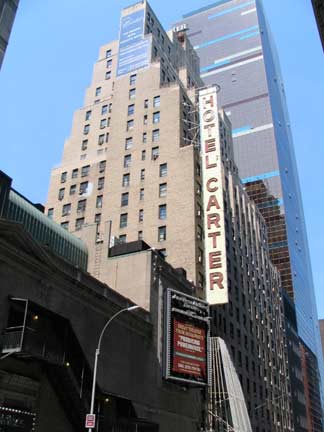
The Hotel Carter, known by some as “the worst hotel in NYC,” is next door. It was constructed in 1929 and was known as the Dixie until 1976. It was a homeless shelter in the 1980s.
Check out the Hotel Carter…
http://www.youtube.com/watch?v=_CY3-CpqupY
Deuce
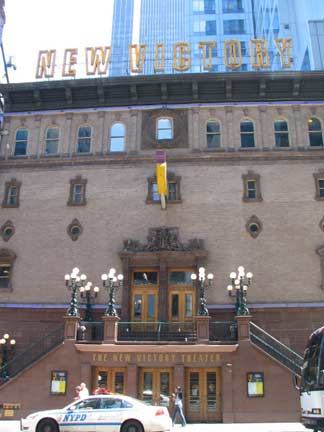
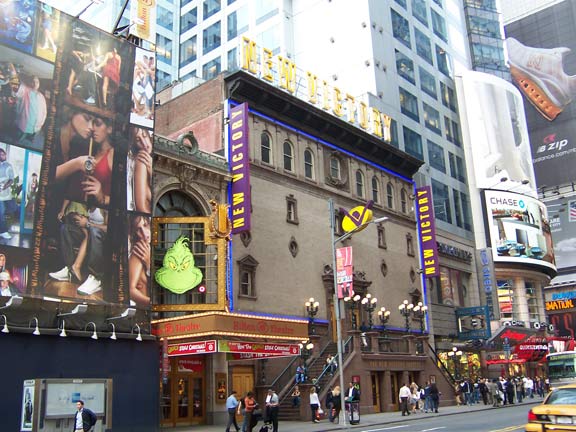
Returning to 42nd Street, on the north side west of 7th Avenue we see the New Victory Theatre, which was built as The Republic in 1899 by Oscar Hammerstein I (from 1902-1910 it was called The Belasco). It was home to Abe, Billy, Herbert and Morton Minsky’s burlesque shows between 1912 and 1937. The show was a launching pad for comics like Phil Silvers, Joey Faye and Red Skelton, and of course famed strippers Gypsy Rose Lee and Ann Corio. Eventually the Fiorello LaGuardia administration forced out the Minskys. The house was raided often, but one such incident inspired a 1968 motion picture starring Jason Robards, Elliott Gould and Britt Ekland.
When the old Republic was restored as the New Victory in 1995, one of the first comebacks on West 42nd, it was decided to devote it exclusively to children’s and family-friendly programming. What would the Minskys say?
The Hilton Theatre occupies the old Apollo Theatre front adjacent to the New Victory. Photo: Michael Minn

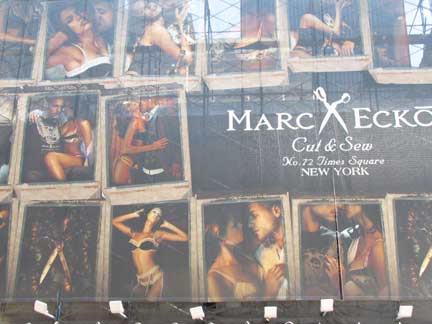
Next door is the old Times Square Theatre, constructed in 1920. Unlike the New Victory, the Times Square remained empty and undeveloped for years after the revival of the rest of the strip until controversial publisher and clothing designer Marc Ecko took over the building for retail operations. Ecko purchased Barry Bonds’ record-breaking 756th home run ball and in 2006, famously battled with Queens City Councilman Peter Vallone Jr. over using graffiti installations to promote his video game. Photo left: Michael Minn
South Side

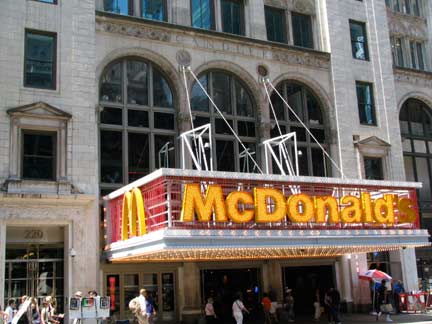
The New Amsterdam‘s gorgeous 1937 white neon-lettered sign and clock. The 1903 theatre is the only landmarked theatre on West 42nd Street and its interior is the most extraordinary of any in the district, with murals by George Peixotto and Robert Blum. The former home of the Ziegfeld Follies and The Lion King musical had a long run here before moving over to the Minskoff Theatre.
The 24-story Candler Building was constructed in 1914 by Coca-Cola founder Asa Candler. Like many skyscrapers constructed from the 1910s on into the Thirties, much of its ornamentation is found on the uper stories and hence is visible only from facing office buildings. It was the first building on 42nd Street that was taller than One Times Square and when built the tallest in Manhattan taller than the Met Life Building on Madison and East 23rd. It has had the Mickey D marquee for about 10 years now.
The last of this stretch of 42nd Street’s elderly theatres is the Eltinge, built in 1912 — just two years before the Candler Building — but much more along the lines of the Beaux-Arts Era of the century’s turn, with elaborate terra cotta sculture.
The theatre was renamed the Laff when it began showing movies in 1942 and again as The Empire in 1954, taking over the name of a nearby demolished theatre. Only the exterior remains from the original Eltinge, as the remainder was demolished and the ‘outside’ was moved about 150 feet west to accommodate the construction of Tussaud’s Wax Museum. It was originally named for vaudevilian Julian Eltinge, the “cute beaut from Butte.”

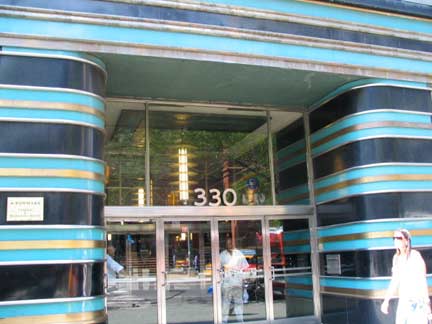
Some architecture critics have sniffed at Raymond Hood’s 1931 McGraw-Hill Building, but I have always admired it not least for its aqua color. It used to be even greener, as the windows were originally outlined with bright green. Like theTimes Building on West 43rd, the McGraw Hill Building originally housed a massive printing plant. As you can see it has been dwarfed by the adjoining Orion condo tower.
Rumor has it, by the way, that a tall condo tower is in the works for the top of the Port Authority Bus Terminal; try as it might, the city has never been able to completely expunge the whiff of depredation and danger from the place. After years as a parking lot, the Se corner of 8th Avenue and West 42nd is getting its own skyscraper as well.
West of 8th
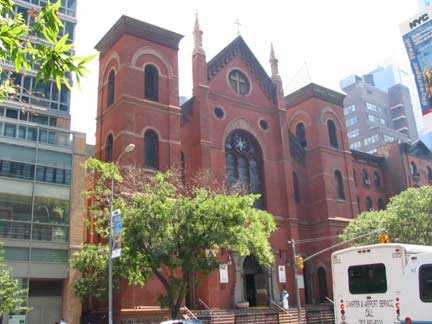
The 1870 Roman Catholic Holy Cross Church was the parish of Father Francis Duffy, who is memorialized in Duffy Square on Broadway and West 47th Street
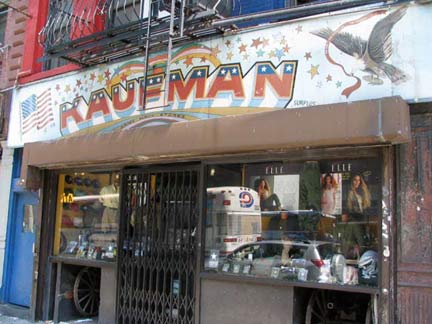
Kaufman’s Army-Navy Store, with its patriotically-themed hand-painted sign, is on the ground floor of an 1875 tenement building. The military surplus store has been in this location since 1946 and it has displayed two U.S. Army Spanish-American War period Hotchkiss mountain cannon (partially shown at the bottom) since 1950.
Meet Me At The Elk

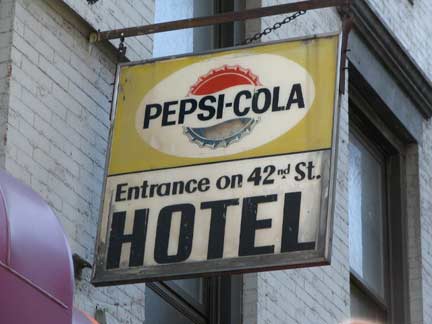
The Deuce’s last flop: The Elk Hotel, SE corner of West 42nd and 9th Avenue. The Times’ Steven Kurutz dropped in in 2004:
A rickety old staircase leads from the street up to a locked glass door, where guests are buzzed into a tiny lobby. To the right and lining the first floor arethe ”short stay” rooms, whichrent for $25 for two hours; to the left and up a flight reside longer-term guests.Moving along the hallways, painted a dizzying aqua, and peeking into the rooms, one can almost imagine the figures that once ran rampant in old Times Square: teenage runaways, ex-cons, junkies and hustlers, lonely drunks, all the lost souls that nested here for a time.
The hotel has lately been popular with Mexican workers, and this day two laborers, their jeans and boots covered in dust, sat on the lobby stairwell eating rice and beans. Men followed by scantily clad women bounded up the stairs most of the day.
The hotel also has a few permanent residents who pay anywhere from $115 to $350 a month. Teddy, a withered black man, has lived there for 35 years. He had no time to talk, however; he had a hot plate going in his tiny room.
In Room 201 were a couple of sightseers who had taken the bus up from Atlanta, a short man with a red mustache and a teenage boy. In town for a week, they inquired at one hotel that charged $280 a night, then another that wanted $100 and then, finally, they came across the Elk.
How were they finding the accommodations? ”Other than the mice, the hookers and the transvestites,” the man said, ”it’s fine.”
The Elk closed for good in February 2012.
photographed July 2007; page completed September 14, 2008
erpietri@earthlink.net
©2008

